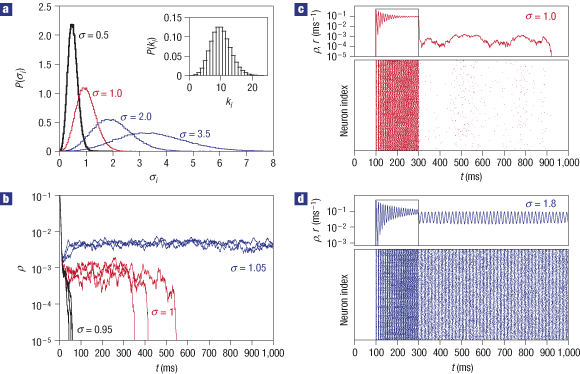
- Select a language for the TTS:
- UK English Female
- UK English Male
- US English Female
- US English Male
- Australian Female
- Australian Male
- Language selected: (auto detect) - EN
Play all audios:
ABSTRACT A recurrent idea in the study of complex systems is that optimal information processing is to be found near phase transitions. However, this heuristic hypothesis has few (if any)
concrete realizations where a standard and biologically relevant quantity is optimized at criticality. Here we give a clear example of such a phenomenon: a network of excitable elements has
its sensitivity and dynamic range maximized at the critical point of a non-equilibrium phase transition. Our results are compatible with the essential role of gap junctions in olfactory
glomeruli and retinal ganglionar cell output. Synchronization and global oscillations also emerge from the network dynamics. We propose that the main functional role of electrical coupling
is to provide an enhancement of dynamic range, therefore allowing the coding of information spanning several orders of magnitude. The mechanism could provide a microscopic neural basis for
psychophysical laws. Access through your institution Buy or subscribe This is a preview of subscription content, access via your institution ACCESS OPTIONS Access through your institution
Subscribe to this journal Receive 12 print issues and online access $259.00 per year only $21.58 per issue Learn more Buy this article * Purchase on SpringerLink * Instant access to full
article PDF Buy now Prices may be subject to local taxes which are calculated during checkout ADDITIONAL ACCESS OPTIONS: * Log in * Learn about institutional subscriptions * Read our FAQs *
Contact customer support SIMILAR CONTENT BEING VIEWED BY OTHERS DISTINCT EFFECTS OF HETEROGENEITY AND NOISE ON GAMMA OSCILLATION IN A MODEL OF NEURONAL NETWORK WITH DIFFERENT REVERSAL
POTENTIAL Article Open access 21 June 2021 POWER SPECTRUM AND CRITICAL EXPONENTS IN THE 2D STOCHASTIC WILSON–COWAN MODEL Article Open access 19 December 2022 DIFFUSE NEURAL COUPLING MEDIATES
COMPLEX NETWORK DYNAMICS THROUGH THE FORMATION OF QUASI-CRITICAL BRAIN STATES Article Open access 10 December 2020 REFERENCES * Stevens, S. S. _Psychophysics: Introduction to its
Perceptual, Neural and Social Prospects_ (Wiley, New York, 1975). Google Scholar * Wachowiak, M. & Cohen, L. B. Representation of odorants by receptor neuron input to the mouse
olfactory bulb. _Neuron_ 32, 723–735 (2001). Article Google Scholar * Angioy, A. M., Desogus, A., Barbarossa, I. T., Anderson, P. & Hansson, B. S. Extreme sensitivity in an olfactory
system. _Chem. Senses_ 28, 279–284 (2003). Article Google Scholar * Fried, H. U., Fuss, S. H. & Korsching, S. I. Selective imaging of presynaptic activity in the mouse olfactory bulb
shows concentration and structure dependence of odor responses in identified glomeruli. _Proc. Natl Acad. Sci. USA_ 99, 3222–3227 (2002). Article ADS Google Scholar * Cleland, T. A. &
Linster, C. Concentration tuning mediated by spare receptor capacity in olfactory sensory neurons: a theoretical study. _Neural Comput._ 11, 1673–1690 (1999). Article Google Scholar *
Copelli, M., Roque, A. C., Oliveira, R. F. & Kinouchi, O. Physics of psychophysics: Stevens and Weber-Fechner laws are transfer functions of excitable media. _Phys. Rev. E_ 65, 060901
(2002). Article ADS Google Scholar * Copelli, M. & Kinouchi, O. Intensity coding in two-dimensional excitable neural networks. _Physica A_ 349, 431–442 (2005). Article ADS Google
Scholar * Copelli, M., Oliveira, R. F., Roque, A. C. & Kinouchi, O. Signal compression in the sensory periphery. _Neurocomputing_ 65–66, 691–696 (2005). Article Google Scholar *
Reiser, J. & Matthews, H. Response properties of isolated mouse olfactory receptor cells. _J. Physiol._ 530, 113–122 (2001). Article Google Scholar * Tomaru, A. & Kurahashi, T.
Mechanisms determining the dynamic range of the bullfrog olfactory receptor cell. _J. Neurophysiol._ 93, 1880–1888 (2005). Article Google Scholar * Chater, N. & Brown, G. D.
Scale-invariance as a unifying psychological principle. _Cognition_ 69, B17–B24 (1999). Article Google Scholar * Furtado, L. S. & Copelli, M. Response of electrically coupled spiking
neurons: a cellular automaton approach. _Phys. Rev. E_ 73, 011907 (2006). Article ADS Google Scholar * Beggs, J. M. & Plenz, D. Neuronal avalanches in neocortical circuits. _J.
Neurosci._ 23, 11167–11177 (2003). Article Google Scholar * Haldeman, C. & Beggs, J. M. Critical branching captures activity in living neural networks and maximizes the number of
metastable states. _Phys. Rev. Lett._ 94, 058101 (2005). Article ADS Google Scholar * Langton, C. G. Computation at the edge of chaos: phase transitions and emergent computation. _Physica
D_ 42, 12–37 (1990). Article ADS MathSciNet Google Scholar * Bak, P. _How Nature Works: The Science of Self-Organized Criticality_ (Oxford Univ. Press, New York, 1997). MATH Google
Scholar * Chialvo, D. R. Critical brain networks. _Physica A_ 340, 756–765 (2004). Article ADS Google Scholar * Kosaka, T., Deans, M. R., Paul, D. L. & Kosaka, K. Neuronal gap
junctions in the mouse main olfactory bulb: morphological analyses on transgenic mice. _Neuroscience_ 134, 757–769 (2005). Article Google Scholar * Migliore, M., Hines, M. L. &
Shepherd, G. M. The role of distal dendritic gap junctions in synchronization of mitral cell axonal output. _J. Comput. Neurosci._ 18, 151–161 (2005). Article Google Scholar * Christie, J.
M. et al. Connexin36 mediates spike synchrony in olfactory bulb glomeruli. _Neuron_ 46, 761–772 (2005). Article Google Scholar * Marro, J. & Dickman, R. _Nonequilibrium Phase
Transitions in Lattice Models_ (Cambridge Univ. Press, Cambridge, 1999). Book Google Scholar * Laurent, G. Olfactory network dynamics and the coding of multidimensional signals. _Nature
Rev. Neurosci._ 3, 884–895 (2002). Article Google Scholar * Lewis, T. J. & Rinzel, J. Topological target patterns and population oscillations in a network with random gap junctional
coupling. _Neurocomputing_ 38–40, 763–768 (2001). Article Google Scholar * Lewis, T. J. & Rinzel, J. Self-organized synchronous oscillations in a network of excitable cells coupled by
gap junctions. _Network Comput. Neural Syst._ 11, 299–320 (2000). Article Google Scholar * Schubert, T. et al. Connexin36 mediates gap junctional coupling of alpha-ganglion cells in mouse
retina. _J. Comp. Neurol._ 485, 191–201 (2005). Article Google Scholar * Hidaka, S., Akahori, Y. & Kurosawa, Y. Cellular/molecular dendrodendritic electrical synapses between mammalian
retinal ganglion cells. _J. Neurosci._ 24, 10553–10567 (2005). Article Google Scholar * Vogt, A., Hormuzdi, S. G. & Monyer, H. Pannexin1 and Pannexin2 expression in the developing and
mature rat brain. _Brain Res. Mol. Brain Res._ 141, 113–120 (2005). Article Google Scholar * Deans, M. R., Volgyi, B., Goodenough, D. A., Bloomfield, S. A. & Paul, D. L. Connexin36 is
essential for transmission of rod-mediated visual signals in the mammalian retina. _Neuron_ 36, 703–712 (2002). Article Google Scholar * Zhang, C. & Restrepo, D. Expression of
connexin 45 in the olfactory system. _Brain Res._ 929, 37–47 (2002). Article Google Scholar * Camalet, S., Duke, T., Jülicher, F. & Prost, J. Auditory sensitivity provided by
self-tuned critical oscillations of hair cells. _Proc. Natl Acad. Sci. USA_ 97, 3183–3188 (2000). Article ADS Google Scholar * Sohl, G., Maxeiner, S. & Willecke, K. Expression and
functions of neuronal gap junctions. _Nature Rev. Neurosci._ 6, 191–200 (2005). Article Google Scholar Download references ACKNOWLEDGEMENTS This research is supported by CNPq, FACEPE,
CAPES and PRONEX. The authors are grateful for discussions with A. C. Roque, R. F. Oliveira, D. Restrepo, T. Cleland and V. R. Vitorino de Assis and for encouragement from N. Caticha. AUTHOR
INFORMATION Author notes * Osame Kinouchi and Mauro Copelli: These authors contributed equally to this work AUTHORS AND AFFILIATIONS * Departamento de Física e Matemática, Faculdade de
Filosofia, Ciências e Letras de Ribeirão Preto, Universidade de São Paulo, Av. dos Bandeirantes 3900, 14040-901 Ribeirão Preto, SP, Brazil Osame Kinouchi * Departamento de Física,
Laboratório de Física Teórica e Computacional, Universidade Federal de Pernambuco, 50670-901 Recife, PE, Brazil Mauro Copelli Authors * Osame Kinouchi View author publications You can also
search for this author inPubMed Google Scholar * Mauro Copelli View author publications You can also search for this author inPubMed Google Scholar CORRESPONDING AUTHOR Correspondence to
Osame Kinouchi. ETHICS DECLARATIONS COMPETING INTERESTS The authors declare no competing financial interests. RIGHTS AND PERMISSIONS Reprints and permissions ABOUT THIS ARTICLE CITE THIS
ARTICLE Kinouchi, O., Copelli, M. Optimal dynamical range of excitable networks at criticality. _Nature Phys_ 2, 348–351 (2006). https://doi.org/10.1038/nphys289 Download citation *
Received: 06 February 2006 * Accepted: 27 March 2006 * Published: 23 April 2006 * Issue Date: May 2006 * DOI: https://doi.org/10.1038/nphys289 SHARE THIS ARTICLE Anyone you share the
following link with will be able to read this content: Get shareable link Sorry, a shareable link is not currently available for this article. Copy to clipboard Provided by the Springer
Nature SharedIt content-sharing initiative







